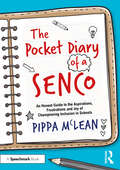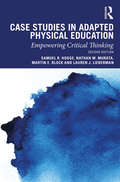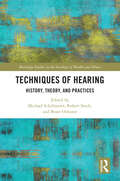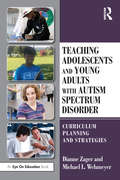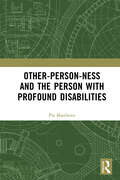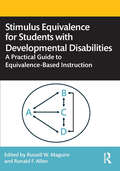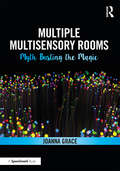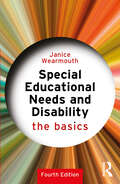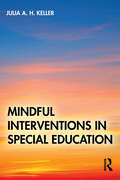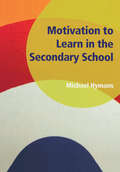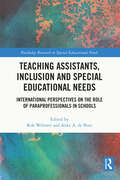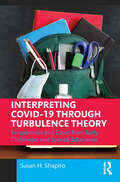- Table View
- List View
The Pocket Diary of a SENCO: An Honest Guide to the Aspirations, Frustrations and Joys of Championing Inclusion in Schools
by Pippa McLeanThe Pocket Diary of a SENCO spans a typical school year and includes hopeful and often humorous diary entries that share the authentic aspirations, joys, and frustrations of championing inclusion and working in the role of a SENCO. Grounded in real-life experiences and day-to-day practice, Pippa McLean describes the experiences of a SENCO and the reality of SEND provision in school, drawing out the personal characteristics and values that schools can foster to support inclusive practice and nurture positive relationships between children, parents, and colleagues. Diary extracts across the months range from ‘Be ready to hit the road’, ‘Be gentle on yourself’, to ‘Be a culture builder' and ‘Be an advocate'. Each entry is followed by reflective questions and space for the reader to jot down their own thoughts, as well as ‘monthly musings’ to support their own professional development. Written in a truly conversational style, this essential pocket diary captures the reality of SEND provision in schools and will be relatable to many. It is valuable reading for SENCOs, teachers, support staff and trainees who wish to enrich their learning around inclusive practice and engage reflectively within their busy lives.
Case Studies in Adapted Physical Education: Empowering Critical Thinking
by Martin Block Lauren Lieberman Nathan Murata Samuel HodgeCovering self-contained adapted physical education classes, general physical education programs, and youth sports and community recreation, this book presents a series of case studies of teaching individuals of varied ability and disability in physicalactivity settings. Outlining realistic scenarios, it encourages an interactive, problem-solving teaching and learning style and the development of critical thinking skills. Now in a fully revised and updated second edition, the book covers a wide range of different professional issues, themes, disabilities, and conditions, from assessment and behavior management processes to working with students with intellectual disabilities, motor difficulties, chronic illness, or obesity. Each case study includes questions that challenge the reader to ref lect on the practical issues involved and how to build inclusive teaching strategies. This book is valuable reading for all physical education students, teacher candidates, and novice and experienced teachers looking to deepen their understanding of adapted physical education and to improve their professional practice. It is an essential companion to any adapted physical education or physical activity course.
Techniques of Hearing: History, Theory and Practices
by Michael Schillmeier, Robert Stock, and Beate OchsnerHearing, health and technologies are entangled in multi-faceted ways. The edited volume addresses this complex relationship by arguing that modern hearing was and is increasingly linked to and mediated by technological innovations. By providing a set of original interdisciplinary investigations that sheds new light on the history, theory and practices of hearing techniques, it is able to explore the heterogeneous entanglements of sound, hearing practices, technologies and health issues. As the first book to bring together historians, scholars from media studies, social sciences, cultural studies, acoustics and neuroscientists, the volume discusses modern technologies and their decisive impact on how ‘normal’ hearing, enhanced and smart hearing as well as hearing impairment have been configured. It brings both new insights into the histories of hearing technologies as well as allowing us to better understand how enabling hearing technologies have currently been unfolding an increasingly hybrid ecology engaging smart hearing devices and offering stress-free hearing and acoustic wellbeing in novel auditory environments. The volume will be of interest to all scholars and students of disability studies, sound studies, sociology of health and illness, medical history, health and society as well as those interested in the practices and techniques of self-monitored and smart hearing.
Teaching Adolescents and Young Adults with Autism Spectrum Disorder: Curriculum Planning and Strategies
by Michael L. Wehmeyer Dianne ZagerTeaching Adolescents and Young Adults with Autism Spectrum Disorder supports teachers in preparing secondary students with autism spectrum disorder (ASD) to succeed in school, work and beyond. Focused on enabling students to successfully pursue further education and meaningful career paths, chapters incorporate person-centered, student-directed planning into instructional programming throughout the text. Featuring helpful vignettes to demonstrate concepts in action, curriculum areas address community living skills, academics, social communication and interaction, and career preparation. Grounded in current research and Universal Design for Learning practices, this guide is an essential resource for educators, therapists, and anyone seeking to create fluid, adaptable programs for students with autism spectrum disorders.
Other-person-ness and the Person with Profound Disabilities
by Pia MatthewsMany people think that profound disability presents us with a real problem, often because it seems difficult to connect with someone who does not seem to think or act like us. Positioning profound disability in this way immediately sets up a ‘them’ and ‘us’, where the person with profound disability becomes the problematic ‘other’. Attempts to bridge the ‘them’ and ‘us’ risk reducing everyone to the same where disability is not taken seriously.In contrast to a ‘them’ and ‘us’, and negative connotations of the other found in the existentialist philosophies of writers like Sartre and Beauvoir, Pia Matthews argues for a return to a positive view of the other. One positive approach to the other, based on an ethics of relationship as championed by Levinas, seems to mitigate the other-ness of profound disability. However, this still makes the person with profound disability dependent on the ethical concern of the more powerful other. Instead, this book argues for return to a personalist philosophy of being offered by Mounier, Marcel, and Wojtyła, and deepened by participation, belonging, and the possibility of contributing to the good of all. This deepened philosophy of being gives a more solid foundation for people who are especially at the mercy of others. It will be of interest to all scholars and students of disability studies, philosophy and anthropology.
Stimulus Equivalence for Students with Developmental Disabilities: A Practical Guide to Equivalence-Based Instruction
by Russell W. Maguire Ronald F. AllenStimulus Equivalence for Students with Developmental Disabilities provides a step-by-step program for converting lesson plans into equivalence-based instruction. Using language and tools accessible to both students and practitioners, chapters present the concept of equivalence-based instruction and include clear and concise procedural descriptions, as well as data sheets and PowerPoint slides, with replaceable stimuli, so that special educators and clinicians will be able to immediately implement this procedure to teach any academic skill. Written in engaging prose with an emphasis on practical application, this book is an essential resource for special educators and graduate students studying to become BCBAs and special educators.
Steven the Snail: Targeting s Blends (Speech Bubbles 1)
by Melissa PalmerSteven is having a birthday party, but it’s a long journey to the party. Will me make it in time, and in one piece? This picture book targets /s/ blends, and is part of Speech Bubbles 1, a series of picture books that target specific speech sounds within the story. The series can be used for children receiving speech therapy, for children who have a speech sound delay/disorder, or simply as an activity for children’s speech sound development and/or phonological awareness. They are ideal for use by parents, teachers or caregivers. Bright pictures and a fun story create an engaging activity perfect for sound awareness. Please see other titles in the series for stories targeting other speech sounds.
Sally's Sandcastles: Targeting the s Sound (Speech Bubbles 1)
by Melissa PalmerA day at the seaside sounds magical to Sally, who brings her bucket and spade for a sandcastle making adventure. This picture book targets the /s/ sound, and is part of Speech Bubbles 1, a series of picture books that target specific speech sounds within the story. The series can be used for children receiving speech therapy, for children who have a speech sound delay/disorder, or simply as an activity for children’s speech sound development and/or phonological awareness. They are ideal for use by parents, teachers or caregivers. Bright pictures and a fun story create an engaging activity perfect for sound awareness. Please see other titles in the series for stories targeting other speech sounds.
Muffin the Fish: Targeting the f Sound (Speech Bubbles 1)
by Melissa PalmerMuffin is a quirky little fish full of fun ideas. What will he get up to next? This picture book targets the /f/ sound, and is part of Speech Bubbles 1, a series of picture books that target specific speech sounds within the story. The series can be used for children receiving speech therapy, for children who have a speech sound delay/disorder, or simply as an activity for children’s speech sound development and/or phonological awareness. They are ideal for use by parents, teachers or caregivers. Bright pictures and a fun story create an engaging activity perfect for sound awareness. Please see other titles in the series for stories targeting other speech sounds.
A Bunny Called Noodle: Targeting the n Sound (Speech Bubbles 1)
by Melissa PalmerNoodle loves to jump in muddy puddles, and his friends don’t understand. Will he ever make a friend who accepts him? This picture book targets the /n/ sound, and is part of Speech Bubbles 1, a series of picture books that target specific speech sounds within the story. The series can be used for children receiving speech therapy, for children who have a speech sound delay/disorder, or simply as an activity for children’s speech sound development and/or phonological awareness. They are ideal for use by parents, teachers or caregivers. Bright pictures and a fun story create an engaging activity perfect for sound awareness. Please see other titles in the series for stories targeting other speech sounds.
Where's Mummy Mouse?: Targeting the m Sound (Speech Bubbles 1)
by Melissa PalmerMolly mouse wakes to find her Mummy has vanished, so she sets off to find her – meeting some interesting creatures along the way. This picture book targets the /m/ sound, and is part of Speech Bubbles 1, a series of picture books that target specific speech sounds within the story. The series can be used for children receiving speech therapy, for children who have a speech sound delay/disorder, or simply as an activity for children’s speech sound development and/or phonological awareness. They are ideal for use by parents, teachers or caregivers. Bright pictures and a fun story create an engaging activity perfect for sound awareness. Please see other titles in the series for stories targeting other speech sounds.
Crocodiles Can't Climb Trees: Targeting the k Sound (Speech Bubbles 1)
by Melissa PalmerLucas the Monkey loves to play soccer by the river, but he has a problem – Mr. Crocodile, who would love to make Lucas his dinner. This picture book targets the /k/ sound, and is part of Speech Bubbles 1, a series of picture books that target specific speech sounds within the story. The series can be used for children receiving speech therapy, for children who have a speech sound delay/disorder, or simply as an activity for children’s speech sound development and/or phonological awareness. They are ideal for use by parents, teachers or caregivers. Bright pictures and a fun story create an engaging activity perfect for sound awareness. Please see other titles in the series for stories targeting other speech sounds.
Gus the Gulping Goat: Targeting the g Sound (Speech Bubbles 1)
by Melissa PalmerGus loves to gulp yoghurt, but he is not the only one. Has he met his match? This picture book targets the /g/ sound, and is part of Speech Bubbles 1, a series of picture books that target specific speech sounds within the story. The series can be used for children receiving speech therapy, for children who have a speech sound delay/disorder, or simply as an activity for children’s speech sound development and/or phonological awareness. They are ideal for use by parents, teachers or caregivers. Bright pictures and a fun story create an engaging activity perfect for sound awareness. Please see other titles in the series for stories targeting other speech sounds.
Polly's Pink Paint: Targeting the p Sound (Speech Bubbles 1)
by Melissa PalmerPolly the pig loves pink – but her friends do not. Can they work it out? This picture book targets the /p/ sound, and is part of Speech Bubbles 1, a series of picture books that target specific speech sounds within the story. The series can be used for children receiving speech therapy, for children who have a speech sound delay/disorder, or simply as an activity for children’s speech sound development and/or phonological awareness. They are ideal for use by parents, teachers or caregivers. Bright pictures and a fun story create an engaging activity perfect for sound awareness. Please see other titles in the series for stories targeting other speech sounds.
Ben the Bubble Bear: Targeting the b Sound (Speech Bubbles 1)
by Melissa PalmerBen the bear loves to blow bubbles, but what happens when he tries to blow the biggest bubble in the world? This picture book targets the /b/ sound, and is part of Speech Bubbles 1, a series of picture books that target specific speech sounds within the story. The series can be used for children receiving speech therapy, for children who have a speech sound delay/disorder, or simply as an activity for children’s speech sound development and/or phonological awareness. They are ideal for use by parents, teachers or caregivers. Bright pictures and a fun story create an engaging activity perfect for sound awareness. Please see other titles in the series for stories targeting other speech sounds.
Who Bit My Tail?: Targeting the t Sound (Speech Bubbles 1)
by Melissa PalmerTiger wakes from a dream to find a big bite on his tail – but can he discover who is the culprit? This picture book targets the /t/ sound, and is part of Speech Bubbles 1, a series of picture books that target specific speech sounds within the story. The series can be used for children receiving speech therapy, for children who have a speech sound delay/disorder, or simply as an activity for children’s speech sound development and/or phonological awareness. They are ideal for use by parents, teachers or caregivers. Bright pictures and a fun story create an engaging activity perfect for sound awareness. Please see other titles in the series for stories targeting other speech sounds.
Speech Bubbles 1 User Guide: Supporting Speech Sound Development in Children (Speech Bubbles 1)
by Melissa PalmerThis book is the supporting guide for Speech Bubbles 1,the first set in an exciting new series of picture books designed to be used by Speech Language Therapists/Pathologists, parents/caregivers, and teachers with children who have delayed or disordered speech sound development, children receiving speech therapy, or by those wanting to provide sound awareness activities for their children. This user guide contains notes for both professionals and caregivers, to support the use of one or all of the picture books in the series.
Pip and Bunny: Pip at Home (Supporting Language and Emotional Development in the Early Years through Reading)
by Maureen GlynnPip at Home is the sixth book in the invaluable ‘Pip and Bunny’ collection; a set of six picture books with an accompanying handbook and e-resources carefully written and illustrated to support the development of visual and literary skills. By inspiring conversation and imagination, the books promote emotional and social literacy in the young reader. Designed for use within the early years setting or at home, each story explores different areas of social and emotional development. The full set includes: six beautifully illustrated picture books with text and vocabulary for each a handbook designed to guide the adult in using the books effectively ‘Talking Points’ relating to the child’s own world ‘What’s the Word?’ picture pages to be photocopied, downloaded or printed for language development detailed suggestions as to how to link with other EYFS areas of learning. The set is designed to be used in both individual and group settings. It will be a valuable resource for teachers, SENCOs (pre-school and reception), Early Years Staff (nursery, preschool and reception), EOTAs, Educational Psychologists, Counsellors and Speech Therapists.
Multiple Multisensory Rooms: Myth Busting the Magic
by Joanna GraceMultisensory rooms are widely used across the country in schools, care settings, hospitals and homes. Even settings such as football stadiums and airports are installing multisensory environments. Nevertheless, a significant lack of effective research has led to a sense of unease around sensory rooms. This crucial book explores the use of multisensory rooms in order to ease that anxiety; taking the mystery out of multisensory rooms, and supporting the reader to reflect and make the most out of their space. Key features include: Guidance on creating sensory spaces on any budget, to suit any level of need. An overview of the history of multisensory rooms, and a detailed exploration of the actual way in which the rooms are used today. A framework for evaluating existing practices and equipment, in order to maximise the potential of the room. A focus on the practitioner as the most important piece of ‘equipment’ in any sensory room. Written by a leading sensory specialist in a fully accessible way, this book is an invaluable tool for anybody who uses, or is considering using, a multisensory room.
Supporting Autistic Children at Home: A Practical Guide for Parents and Caregivers
by Dawn ConnorThis practical guide offers a wealth of advice to support parents and caregivers who have an autistic child within their family. It provides accessible and straightforward information on the topics that matter most, from initial questions around diagnosis, to providing the best home support. Chapters also debunk myths commonly held about autism and signpost appropriate support mechanisms, including ideas to help with sleep, diet, sensory sensitivities, social interactions, communication, and much more. The emphasis throughout is on offering practical strategies to give much-needed, meaningful support to the child’s main caregivers and other family members, in an easily digestible format. Written from the author’s joint perspective as a qualified teacher with an expertise in autism, and as a grandmother of an autistic grandchild, this book is an essential guide for parents and caregivers, created by someone who understands and appreciates what it is like to walk in their shoes.
Special Educational Needs and Disability: The Basics (The Basics)
by Janice WearmouthSpecial Educational Needs and Disability provides a clear, coherent overview of the historical development of the field of special educational, or additional learning or support needs and disability, and discusses important past and current social and political contexts in which this took place, as well as changes in the law across time. It offers broad coverage of a range of needs and disabilities, and how to effectively identify and support those young people who experience such needs. This revised fourth edition covers recent legislative changes across the UK, an expanded discussion of key areas such as social, emotional, and mental health, a new chapter on literacy difficulties, and further fair, balanced, and open discussion of up-to-date evidence that indicates how young people who experience barriers to their learning are affected by factors associated with such marketisation, for example competition between schools and the academies programme. Special Educational Needs and Disability serves as essential reading for trainee and practising teachers, members of governing boards in schools and colleges, policymakers, and all those working directly with learners and their families.
Mindful Interventions in Special Education
by Julia A. KellerBridging the gap between theory and practice, Mindful Interventions in Special Education helps aspiring educators develop their intervention toolkit. Covering topics from dyslexia to hypoactivity, each chapter provides an overview of the theoretical and research-based rationale alongside an illustrative case study for each intervention being discussed. Each intervention features mindful and strength-based remediation strategies and reflection questions to deepen readers’ understanding. Addressing a wide array of common scenarios, this thoughtful resource is ideal for anyone seeking to effectively build inclusive classrooms and support students’ social-emotional learning.
Motivation to Learn in the Secondary School
by Michael HymansTeachers have an enormous impact on how their students approach learning situations. Motivation to Learn in the Secondary School provides the opportunity for senior management teams to enhance learning and teaching by looking at theories of motivation and then relating these to the realities of the classroom. The book looks at the role of senior leaders and how they can encourage their staff to: explore the role that student-teacher relationships play in encouraging student motivation; highlight the importance of emotional literacy for motivating teaching and learning; explore a range of ideas to nurture motivation for the promotion of effective teaching and learning, such as accelerated learning, learning styles, multiple intelligences, meta-cognition and thinking skills. Each chapter shows how the concepts and theories convert into practice. These are identified throughout the book as TiPs (Theory into Practice) to: aid understanding of the model; encourage student motivation through particular practices. There are 38 TiPs, which include activities with handouts and information pages. These are designed for individual and/or groups of staff to use for reflection and development of action plans to promote student motivation to learn.
Teaching Assistants, Inclusion and Special Educational Needs: International Perspectives on the Role of Paraprofessionals in Schools (Routledge Research in Special Educational Needs)
by Rob Webster Anke A. de BoerThis book offers the first collection of international academic writing on the topic of Teaching Assistants. It serves as an indicative summary of current research and thinking in this field and as a point of departure for future research and development. With contributions from leading researchers, the book draws together empirical work on the deployment and impact of Teaching Assistants from various perspectives and from a range of methodological approaches. It highlights and celebrates the vital everyday contributions Teaching Assistants make to their schools and their communities: from their role within classrooms, to their moment-by-moment interactions with pupils and teachers. The book examines the effect that Teaching Assistants can have on pupils’ learning and wellbeing, and considers issues of overdependence on classroom paraprofessionals and the unintended consequences to which this can lead. Bringing together work from a journal special issue with brand new and updated chapters, the contributions offer insight into the liminal space between educator, care-giver, behaviour manager, and facilitator of learning and of peer relations, which characterises the Teaching Assistant role. This timely and important book will be essential reading for academics, researchers and students interested in special educational needs, disability, and inclusion, and those interested in the wider topic of paraprofessionals in labour markets.
Interpreting COVID-19 Through Turbulence Theory: Perspectives and Cases from Early Childhood and Special Education
by Susan H. ShapiroThrough the lens of Turbulence Theory, this volume offers students and scholars an innovative toolkit for understanding the COVID-19 pandemic and its impact on teachers, families, and students. Bringing together cases from early childhood and special education written by parents and educators, author Susan H. Shapiro leverages Turbulence Theory as a framework to help readers evaluate the level of turbulence during each scenario and what methods, if any, might help mitigate or escalate the situation. With more than 20 insightful case-based examples and discussion questions, this book explores what lessons and strategies we can bring into future crises—and how we move forward in an ever-evolving educational landscape.
